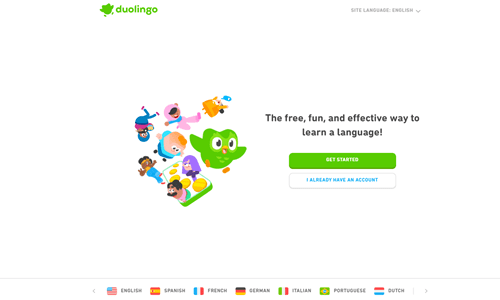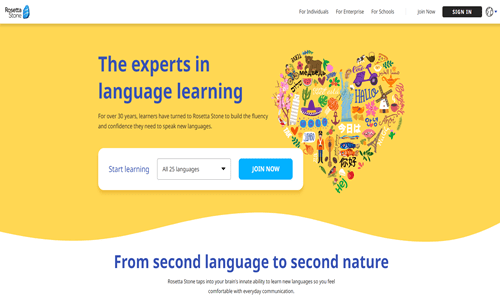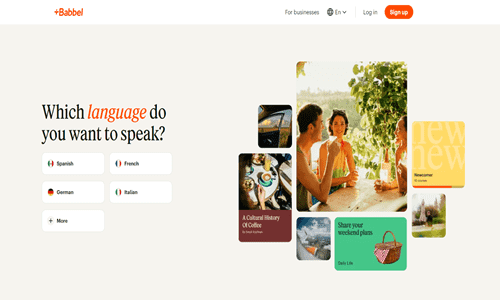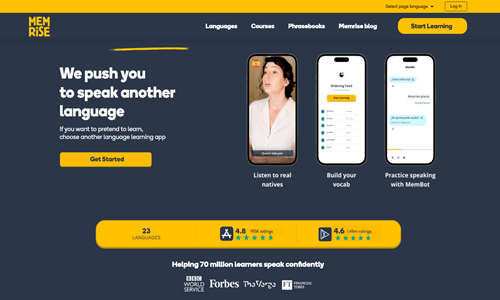
Unlock Your Language Potential with Language Learning Software
In today’s linked world, language learning software provides a creative and efficient method for learning new languages. These software programs use technology to give students a full arsenal for quickly and easily improving their language proficiency. With personalized learning routes, immersive experiences, interactive lessons, and social participation, Language Learning Software enables people to start a life-changing language acquisition journey that suits their specific requirements and interests. These state-of-the-art resources open the door to immersive, captivating, and fulfilling language learning experiences, regardless of your experience level—beginners looking to establish a strong foundation or experienced learners aiming for fluency.
What is Language Learning Software?
Language learning software refers to computer programs or mobile applications designed to help individuals learn and improve their proficiency in one or more foreign languages. These software solutions typically employ interactive methods, such as lessons, games, exercises, and multimedia resources, to engage learners and facilitate language acquisition.
Benefits of Using Language Learning Software
Flexibility and Convenience:
- Study anytime, anywhere, according to your schedule
- There’s no need to drive to actual classrooms or follow set class schedules.
- Accommodates individuals with irregular work hours or busy lifestyles
Personalized Learning Experience:
- Adapts course content and pace based on your learning style and preferences
- Offers customized learning paths tailored to your specific goals and proficiency level
- Provides targeted feedback and recommendations for improvement based on your performance
Multimedia Resources:
- Utilizes a variety of learning materials, including audio recordings, videos, interactive exercises, and cultural content
- Engages multiple senses and learning modalities to enhance retention and understanding
- Exposes learners to authentic language usage in real-life contexts, fostering practical communication skills
Progress Tracking:
- Offers comprehensive tools for monitoring progress across various language skills (speaking, listening, reading, writing)
- Tracks achievements, proficiency levels, and completion of learning milestones
- helps students to create objectives, see their progress, and maintain motivation while they acquire a language.
Cost-effective:
- Represents a more affordable option compared to traditional language instruction methods (e.g., classroom courses, private tutoring)
- Eliminates additional expenses associated with commuting, textbooks, and course materials
- Provides value for money with access to extensive learning resources, interactive lessons, and ongoing support at a lower cost
Key Features of Language Learning Software
Interactive lessons and exercises:
- Engage learners actively through interactive activities, quizzes, and challenges.
- Provide hands-on practice opportunities to reinforce language skills and concepts.
- Offer immediate feedback to learners to help them understand and correct mistakes effectively.
Speech recognition and pronunciation practice:
- Utilize advanced technology to analyze learners’ spoken language and provide feedback on pronunciation accuracy.
- Offer pronunciation exercises and drills to help learners improve their speaking skills.
- Incorporate voice recognition software to simulate real-life conversations and interactions.
Gamification elements to make learning enjoyable:
- To motivate learners, integrate game-like features such as points, badges, levels, and leaderboards.
- Establish a lively and stimulating learning atmosphere that rewards initiative and perseverance.
- Reward learners for completing tasks, mastering skills, and achieving milestones.
Multimedia resources (audio, video, images):
- Incorporate diverse multimedia content, including audio recordings, video clips, and images.
- Provide authentic language materials from native speakers, movies, TV shows, and cultural events.
- Enhance comprehension and cultural awareness through exposure to real-world contexts and scenarios.
Progress tracking and performance analysis:
- Enable learners to track their progress, set goals, and monitor their performance over time.
- Provide detailed analytics and reports on learners’ strengths, weaknesses, and areas for improvement.
- Offer insights into learning patterns, study habits, and mastery of language skills.
Vocabulary builders and flashcard systems:
- Offer tools and resources to expand learners’ vocabulary and improve retention of new words and phrases.
- Provide interactive flashcards, word lists, and vocabulary games to help learners memorize and practice vocabulary.
- Offer context-based learning activities to reinforce vocabulary in meaningful contexts.
Grammar explanations and practice:
- Give brief, precise explanations of grammar principles and rules.
- Offer grammar exercises, drills, and quizzes to help learners apply and reinforce grammar rules.
- Include grammar reference materials and resources for self-directed study and review.
Simulated conversations and role-playing scenarios:
- Give students the chance to practice conversing in contexts that mimic real-life scenarios.
- Offer role-playing activities, dialogues, and scenarios to encourage interaction and communication.
- Mimic authentic language exchanges and social interactions to prepare learners for real-world conversations.
Adaptive learning algorithms for personalized content:
- Analyze the performance and preferences of learners using machine learning and AI techniques.
- Dynamically adjust course content, difficulty levels, and learning paths based on individual needs and progress.
- Offer personalized recommendations, suggestions, and feedback to optimize learning outcomes and enhance engagement.
Types of Language Learning Software
Comprehensive language learning platforms:
- These platforms provide comprehensive solutions that address various facets of language acquisition, such as reading, writing, speaking, listening, grammar, and vocabulary.
- They typically provide a comprehensive curriculum with structured lessons and exercises to guide learners from beginner to advanced proficiency.
- Features may include interactive lessons, multimedia resources, progress tracking, and personalized learning paths tailored to individual needs.
Specialized language learning tools:
- These software programs focus on specific areas of language learning, such as vocabulary building, pronunciation practice, or grammar drills.
- They offer targeted exercises and activities to help learners master particular language skills or overcome specific challenges.
- Examples include vocabulary trainers, pronunciation apps, grammar checkers, and verb conjugation tools.
Mobile language learning apps:
- In response to the increased popularity of mobile devices, many companies that provide language learning software have developed apps that allow users to study while on the go.
- These apps offer convenient access to language learning resources anytime, anywhere, enabling learners to fit language study into their busy schedules.
- Features may include interactive lessons, flashcards, quizzes, audio recordings, and offline access to course materials.
Online language learning courses:
- These are web-based platforms that provide structured courses for language learners.
- They offer a variety of courses covering different languages, proficiency levels, and learning objectives.
- Courses may include video lectures, interactive exercises, assignments, quizzes, and assessments.
- Some platforms also offer instructor feedback, peer interaction, and community forums for additional support and engagement.
Supplementary language learning tools:
- These tools complement traditional language learning methods by providing additional resources and support.
- Examples include dictionaries, translators, language exchange platforms, language learning blogs, podcasts, and online forums.
- Using these resources, language learners can improve their vocabulary, practice speaking in natural settings, and establish connections with native speakers and other language learners.
Factors to Consider When Choosing Language Learning Software
Language(s) offered and proficiency levels covered:
- Determine if the software offers the language(s) you want to learn and if it covers proficiency levels suitable for your needs (e.g., beginner, intermediate, and advanced).
- Ensure the software provides comprehensive coverage of all language skills (reading, writing, listening, and speaking) for a well-rounded learning experience.
Learning approach (e.g., immersion, gamification, traditional):
- Consider the software’s learning methodology and whether it fits your learning objectives and style.
- Evaluate whether the software emphasizes immersion techniques, gamification elements, traditional teaching methods, or a combination thereof.
Compatibility with your preferred devices (desktop, mobile, tablet):
- Check if the software is compatible with your learning devices, such as desktop computers, laptops, tablets, or smartphones.
- Ensure the software offers a user-friendly interface and functionality across different platforms for seamless learning experiences.
Availability of multimedia resources and interactive components:
- Look for software that provides various multimedia resources, including audio recordings, video lessons, images, and interactive exercises.
- Evaluate the quality and relevance of multimedia content to ensure engaging and effective learning experiences.
Cost and subscription options:
- Consider how much the program will cost and if you can afford it for your language learning needs.
- Explore different subscription options, such as monthly, yearly, or lifetime memberships, and determine which option offers the best value for your needs.
User reviews and ratings:
- Look for user reviews and ratings to determine the software’s efficacy, dependability, and customer contentment.
- Look for feedback from other learners who have used the software to assess its strengths, weaknesses, and overall performance.
Integration with other language learning resources or communities:
- Determine if the software integrates with other language learning resources or communities that you already use or plan to use.
- Look for compatibility with language exchange platforms, online forums, or supplementary learning tools to enhance your learning experience and connect with other learners.
Best Example of Language Learning Software
Duolingo

Description:
Duolingo is a popular language learning platform that offers interactive lessons in over 30 languages. It uses gamification elements to make learning fun and engaging, with rewards and progress-tracking features.
Pros:
It is free to use with optional premium features, diverse language options, bite-sized lessons suitable for busy schedules, and a mobile app for on-the-go learning.
Cons:
Limited advanced language proficiency may only cater to some learning styles and occasional translation errors.
Rosetta Stone

Description:
Rosetta Stone is a renowned language-learning software known for its immersive approach. It utilizes dynamic immersion techniques, such as image association and speech recognition, to teach languages naturally.
Pros:
Emphasis on immersive learning, speech recognition technology for pronunciation practice, and customizable lesson plans, available for desktop and mobile devices.
Cons:
Higher price points compared to some alternatives, less focus on grammar explanations, and limited free trial options.
Babbel

Description:
Babbel software helps users learn languages by emphasizing useful conversational skills. It provides systematic instruction emphasizing real-world situations, covering grammar, vocabulary, and cultural insights.
Pros:
Tailored lessons based on your native language, speech recognition for pronunciation practice, ability to download lessons for offline use, and progress synchronization across devices.
Cons:
Limited language options compared to some competitors, less emphasis on advanced grammar concepts, and a subscription-based pricing model.
Memrise

Description:
Memrise is a language learning tool that helps users memorize words using mnemonic devices and spaced repetition. It provides a large selection of courses made by community members and specialists.
Pros:
Extensive library of user-generated content, adaptive learning algorithm, multimedia lessons with videos and audio recordings, and community forums for language exchange.
Cons:
The interface can be overwhelming for some users. It has a less structured approach compared to some competitors. The free version includes ads and limits on course access.
FluentU

Description:
FluentU is an immersive language-learning platform that teaches languages through authentic videos, such as movie trailers, music videos, and news clips. It incorporates interactive subtitles, quizzes, and vocabulary lists to reinforce learning.
Pros:
Engaging content from real-world sources, adaptive quizzes based on individual progress, and downloadable audio files for offline practice, suitable for various proficiency levels.
Cons:
Limited language options compared to some competitors, higher subscription cost, and may require supplemental grammar study for comprehensive learning.
Best Practices for Maximizing Language Learning Software Effectiveness
Set clear language learning goals and track your progress regularly:
- Define specific, achievable language learning objectives to guide your study efforts.
- Monitor your progress periodically to assess your proficiency levels and adjust your learning strategies accordingly.
Establish a consistent study routine and allocate dedicated time for language practice:
- To guarantee consistent practice, incorporate language acquisition into your weekly or daily routine.
- Set aside time slots for language study and prioritize consistency and commitment to your learning goals.
Utilize the various features and resources provided by the software:
- Explore and use the software’s features and resources, such as audio exercises, flashcards, grammar lessons, and interactive activities.
- Experiment with different learning tools and techniques to find what works best for you and keeps you motivated.
Engage with the learning community, if available:
- If the software includes a learning community or discussion forum, interact actively with native speakers or fellow learners.
- Practice speaking and writing skills by engaging in language exchanges, group discussions, or collaborative projects with other learners.
Supplement your software-based learning with additional resources:
- Enhance your learning experience by supplementing the software with additional resources like books, movies, podcasts, or language exchange partners.
- Explore authentic language materials to expose yourself to real-world language usage and cultural contexts.
Regularly review and reinforce previously learned material:
- Schedule regular review sessions to revisit and reinforce previously learned vocabulary, grammar rules, and language concepts.
- Use self-tests, flashcards, or spaced repetition strategies to help you retain the information and strengthen your memory.
Challenges and Solutions in Implementing Language Learning Software
Challenge:
Technical Compatibility
Solution:
Rigorous testing is conducted to ensure compatibility across various platforms and devices, ensuring a flawless user experience and performance.
Challenge:
Training and Familiarization
Solution:
Provide users extensive training materials and programs to help them familiarize themselves with the software’s features and capabilities.
Challenge:
Content Localization
Solution:
Establish dedicated teams to localize language learning content, ensuring cultural relevance and linguistic accuracy for diverse user groups.
Challenge:
Engagement and Motivation
Solution:
Incorporate gamification elements, progress tracking, and reward systems to enhance learner engagement and motivation.
Challenge:
Assessment and Feedback
Solution:
Implement automated assessment tools, such as speech recognition and writing evaluation algorithms, to provide immediate feedback to learners and alleviate the burden on instructors.
Future Trends in Language Learning Software
Artificial Intelligence (AI) and adaptive learning:
- Artificial Intelligence and machine learning algorithms will be increasingly used in language learning software to deliver individualized learning experiences.
- AI will adjust to each learner’s unique learning style and progress to enhance learning outcomes, providing individualized content, timing, and feedback.
Virtual and augmented reality (VR/AR):
- Immersive VR and AR technologies will revolutionize language learning by providing realistic simulations of real-world language contexts.
- Learners can practice language skills in virtual environments, such as ordering food in a restaurant or navigating a foreign city, enhancing their language acquisition and cultural understanding.
Integration with the Internet of Things (IoT) and smart devices:
- Language learning software will seamlessly integrate with smart devices and IoT ecosystems, enabling learners to practice languages through everyday interactions with their connected devices.
- IoT-enabled devices like voice assistants and smart speakers will offer language learning opportunities through voice commands, interactive conversations, and contextual prompts.
Social and collaborative learning:
- Language learning platforms will prioritize social and collaborative features, fostering language exchange and practice with native speakers and fellow learners worldwide.
- Learners will connect with others through virtual communities, language exchange forums, and collaborative projects, enhancing their communication skills and cultural competence.
Gamification and interactive narratives:
- Language learning software will incorporate more gamification elements and interactive narratives to enhance engagement and motivation.
- Gamified challenges, storytelling adventures, and role-playing scenarios will make learning enjoyable, immersive, and conducive to long-term retention.
FAQs
Is language learning software effective for beginners?
Yes, most language learning software programs cater to different proficiency levels, including beginners, and provide structured lessons and resources for those starting their language learning journey.
Can language learning software replace traditional classroom instruction or private tutoring?
Language learning software can be an effective supplement to traditional instruction. Still, it may only partially replace the benefits of face-to-face interaction and personalized feedback from a qualified instructor or tutor.
How long does it take to become fluent using language learning software?
The complexity of the target language, the learner’s learning style, and other variables all affect the time it takes to become proficient. Immersion and regular practice are essential, and language learning software can help with both aspects.
Are language learning software programs suitable for all ages?
Most software applications for language learning serve a broad age range, from kids to adults. Certain programs might have versions or user interfaces designed specifically for various age groups.
Conclusion
Language learning software has revolutionized language acquisition, offering a convenient, engaging, and personalized learning experience. With many options available, learners can find software that aligns with their goals, learning styles, and preferences. By leveraging the power of technology and multimedia resources, language learning software can be valuable in your language learning journey, enabling you to develop proficiency and cultural understanding in a globalized world.




